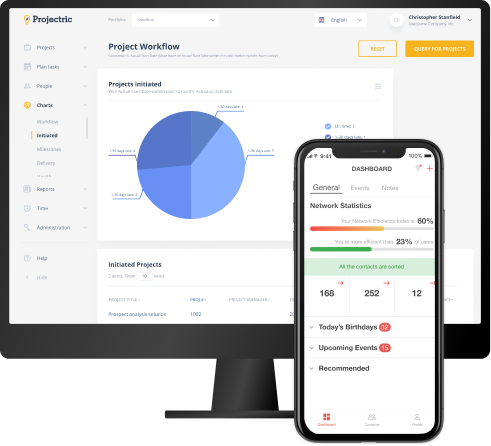
Custom Software Development Service
Benefits of Custom Software for your business
Maximize operational efficiency
Bring innovation
Be invulnerable
Get a full ownership
Become flexible
Gain competitive advantage
Better serve your customers
Maximize operational efficiency
Reach higher efficiency with smartly built custom software that digitizes your processes and make your activities more productive, and profitable. Custom software development, fine-tuned to your specific needs, helps to optimize your business processes compared with Off-the-shelf software that is designed based on a generic set of requirements.
Bring innovation
Astonish your stakeholders by creating out-of-the-box solutions. Hit your sophisticated challenges hard and bring brilliant ideas alive with DOIT Software custom software development and dedicated R&D teams. Implement innovative features and use modern technologies, including AI, Machine Learning, Big Data, AR/VR, Embedded development for your IoT ecosystem, Blockchain, Chatbots, Cloud solutions, and more.
Be invulnerable
Popular software solutions are more vulnerable to hackers’ attacks. A custom developed software solution that is used only by your team will be a secure way to go, especially if you manage personal or confidential data and unique business approaches.
Get a full ownership
Tired of paying subscription fees on solutions that don’t perfectly meet your business needs? Build your own custom software solution with the DOIT Software team. Once the development process is finished, you will receive the complete source code and all the rights to your product.
Become flexible
Develop a bespoke software solution that will be fine-tuned to all your business needs, fit your processes and workflows, no matter how big or complex they are. Scale your software together with your company’s growth.
Gain competitive advantage
Unlike “off-the-shelf” software, your custom software solution will help you to boost your company’s performance. Reach higher efficiency for your company activities with bespoke software. Also, you can earn a profit by licensing or reselling your solution to other organizations.
Better serve your customers
Increase your customers loyalty. Give your users more value by upgrading tools, removing software slow-downs, optimizing the interface, and bringing new amazing features.
Custom Software development technologies and tools
Web and mobile development
Data Science & AI
Other





Processing
Processing
Publisher





Custom software solutions DOIT Software can help you with
development
emerging solutions
solutions
solutions
applications
modernization

Software product
development
Empower your business opportunities, accelerate workflows, boost revenues, solve business challenges and optimize your company's operations with full-cycle custom software development services.
Web app development
Mobile app development
Cloud infrastructure consulting

Next-gen and
emerging solutions
Digital transformation, application development and integration, and steady innovations in a wide palette of industry-specific solutions.
Enterprise Resource Planning (ERP)
Supply Chain Management (SCM)
Customer Relationship Management (CRM)
Business Process Management (BPM)

SaaS
solutions
Stand out in the market with an exceptional and robust SaaS solution that solves key industry and business challenges.
Build custom software using top-notch technologies and intuitive UX/UI design methods.

Custom eCommerce
solutions
Improve your customer experience and optimize your business processes with a custom eCommerce solution.
Add transparency, improve reporting, and digitalize the whole chain in order to sell more.

Third-party
applications
Address unique user needs of both open-source and proprietary software infrastructure by applying targeted expertise and a focused customized approach.

Legacy systems
modernization
Increase your existing software solution performance by optimizing its architecture. Implement enhancements on the go to stay relevant for your users.
Evolve your product with new features development and integrating analytics for data-driven, actionable insights.
Custom software development: case studies
see all cases
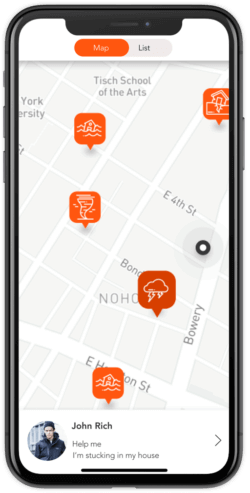
Citizens to the rescue
disaster alerting networking app
The DOIT Software team developed a peer-to-peer application that allows users to deliver real-time emergency information (regarding disasters, property or infrastructure damage, and injuries) and help others in difficult situations.
Location identification, Google Maps API integration, notifications.

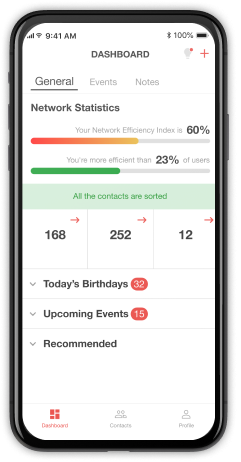
NRM
Social app for contacts management
DOIT Software team developed a proactive network relationship management solution that helps users to analyze their contacts and organize them into specific areas of interest. The system provides sophisticated network efficiency index measurement, using suggested and initiated suitable engagement patterns to predict the most efficient activities. Also, it allows transcribing voice-to-text automatically.
Categorize, group and analyze contacts, see upcoming events.


Yrgent
An Uber-like app for the healthcare industry
The DOIT Software team developed an app that allows users to check doctors’ availability, make an appointment in real-time, and plan a route to the doctors’ office.
Personal information protection, payments within an app, personal profiles management.
What do clients say about DOIT Software?

Kjell Garatun-Tjeldstø
CEO
Jarbtech Solution Group

Gil Dror
CTO
Human Care Systems

Larissa Paschyn
Founder
Citizens to the Rescue

Dean Dzurilla
Product Manager
Visible Impact
DOIT Software covers full-cycle product development. Share your requirements to receive a quote.
Contact us
Domain Focus
HealthCare
Retail and eCommerce
Wellness & Sports
FinTech
Management
Transport and Navigation

optimize the work of medical organizations
provide doctor-on-demand services
manage the treatment and control of drug intake
remotely recognize and diagnose diseases
improve your service via providing high-level remote communication with patients

personalize your customers’ experience to boost conversion rates
analyze your customers' behavior and transform this info into data-driven insights to improve your audience's experience
improve and automate your internal processes with inventory management, out-of-stock prediction and prevention, etc

cover a need in online workout programs
provide services of individual programs creation and progress tracking
increase users engagement through using gamification strategies
popularize a healthy lifestyle

use mobile and online banking for customer retention
decentralize your activities and bring transparency through peer-to-peer solutions implementation
provide personal finance management
analyze customer data and predict accidents for insurance and credit score cases

increase productivity via time and task management
oversee the progress and optimize activities
automate processes within an enterprise (CRM, ERM)

track cargo and productivity in real-time
supply on-demand solutions like taxi-services and food delivery
develop travel and road guide solutions
Bespoke software development process
DOIT Software performs bespoke software development services for startups, SMEs and large enterprises.
Software Requirement Specification
Prototyping
UI/UX design
Software Development
Quality Assurance
Deployment
Support and maintenance
Software Requirement Specification


Prototyping


UI/UX design


Software Development


Quality Assurance


Deployment


Support and maintenance


Ready-made software solutions available on the market can’t fit your business needs?
Contact us to get a free consultation on how bespoke software development can perfectly meet your requirements.
Contact us
DOIT Software approach
Offshore mature developers from Eastern Europe for successful implementation of your project on time and within offshore development rates.
Frequently Asked Questions

 What is custom software development?
What is custom software development?

 What are the benefits of a custom software solution?
What are the benefits of a custom software solution?

 How could my business benefit from custom software?
How could my business benefit from custom software?

 What are the indications that my business needs custom software?
What are the indications that my business needs custom software?

 Why hire a custom software development company?
Why hire a custom software development company?

 What is the difference between custom software solutions and off-the-shelf solutions?
What is the difference between custom software solutions and off-the-shelf solutions?

 What is an example of a customized software?
What is an example of a customized software?

 How much does it cost to develop software?
How much does it cost to develop software?

 How can I identify the right software stack for my requirements?
How can I identify the right software stack for my requirements?
For mobile development, if you choose iOS mobile app development, then Swift and Objective-C are the most prominent languages, whereas for Android, go for Java and Kotlin. Cross-platform custom business application development is also a good option and implies Flutter and React Native. For web development, go for Ruby on Rails, AngularJS, or Node.JS.

 What is the Software Development Life Cycle (SDLC)?
What is the Software Development Life Cycle (SDLC)?

 What is custom software development?
What is custom software development?

 What is the difference between custom software solutions and off-the-shelf solutions?
What is the difference between custom software solutions and off-the-shelf solutions?

 What are the benefits of a custom software solution?
What are the benefits of a custom software solution?

 What is an example of a customized software?
What is an example of a customized software?

 How could my business benefit from custom software?
How could my business benefit from custom software?

 How much does it cost to develop software?
How much does it cost to develop software?

 What are the indications that my business needs custom software?
What are the indications that my business needs custom software?

 How can I identify the right software stack for my requirements?
How can I identify the right software stack for my requirements?
For mobile development, if you choose iOS mobile app development, then Swift and Objective-C are the most prominent languages, whereas for Android, go for Java and Kotlin. Cross-platform custom business application development is also a good option and implies Flutter and React Native. For web development, go for Ruby on Rails, AngularJS, or Node.JS.

 Why hire a custom software development company?
Why hire a custom software development company?

 What is the Software Development Life Cycle (SDLC)?
What is the Software Development Life Cycle (SDLC)?
a custom software solution?
Share your project details and
receive a free consultation.

How to make your custom software development more efficient?
December 3, 2024 | 21 min readWith a large accent on business goals, process optimization and customers, companies these days often choose to build custom-developed software as opposed to an off-the-shelf solution. Custom applications development allows businesses to create a solution that will perfectly suit their business needs, provide scalability, a higher grade of security, as well as attract their target audience. An external, eCommerce tailored solution will improve user experience, whereas an internal tool will streamline business processes and provide automation. Bespoke software development enables you to deliver an application that fits your industry, advantages your business goals and meets your users’ needs. But are there any risks when it comes to custom software application development? How to avoid or mitigate them and why is custom software development important to your business?
What is custom software development?
Unlike an off-the-shelf solution, custom software development refers to designing an application with specific requirements in mind. Commercial off-the-shelf products try to appeal to a wide range of potential users, whereas custom software applications are focused on suiting the exact needs of one specific business. Apart from being custom-made, it follows a common software development process and entails steps like requirements setting, code writing, testing, deploying, etc. It is also a good practice to implement agile methodologies, Continuous Integration and Delivery, and others.
Custom software vs. off-the-shelf software
We have already discussed that custom designed software is an alternative to an off-the-shelf product. Obviously, there are pros and cons to both, which is why we will take a look at the main differences between both options.
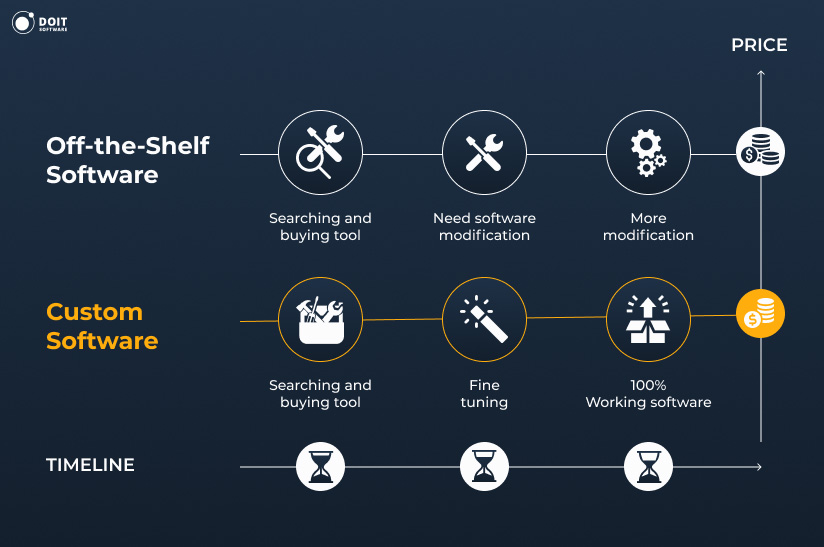
Pros & Cons of custom software development
Now let’s dive deeper into the advantages of custom software, as well as its downsides.
Unique and specific solutions that cover your exact needs and requirements.
Building an application from scratch requires a much higher investment of both time and money.
Custom software development enables as many security layers as you need and can afford, thus making your application safer.
Outsourcing software development to companies has a lot of benefits but also forces you to completely rely on the IT partner. That is why you should choose your IT vendor wisely to prevent risks related to ongoing product support and maintenance.
Seamless integration promotes easier adoption and implementation of the custom solution.
Custom programming allows for easier modification and expansion of the software that corresponds with your needs since you hold control of the development process.
We have covered some of the most common pros and cons of custom software development. Although custom development does take longer and costs more money, it usually pays off due to the competitive advantage of the software perfectly matching your requirements. Moreover, if you find a trustworthy software development firm, you will not be at risk of having issues with a legacy system. Reliable and reputable software product development companies do not abandon their clients and software, and continue to provide technical support even after the implementation.
Custom software development for enterprises
Custom software development for SMEs
Custom software development for startups
Risks and mistakes to avoid when you're building a custom software solution
Building a custom-developed application from scratch can open many doors for you and bring your business to a new level. However, nothing comes without its risks and beginner mistakes. Here is a compilation of the most common mistakes that custom software developers make when working on a tailored solution.
Thinking too ambitiously
Very often managers come up with an exciting and innovative idea that in their heads will appeal to the customers and make their business bloom. In reality, it turns out that it is not what their users need at all, and after spending time and money working on custom application development, managers realize that their idea will not pay off.
Solution: instead of jumping into the development process right away, create an MVP (Minimum Viable Product) that will allow you to test out your idea without spending too many resources. A functional MVP will help you to modify your concept, make it more appealing to the customers, and most importantly, visualize it. This way, when you begin the actual custom application development, you have more information about what works and what doesn’t.
Setting unrealistic goals
If you think that the first version of the application will generate good income, bring in a lot of leads and new clients, and boost brand awareness, you are not being realistic. The market is saturated, which means that you will probably require several releases to get somewhere near this idealistic goal. When it comes to building a program for internal use, unrealistic goals will slow down the development and frustrate everyone involved as your project will be bound to fail.
Solution: For the first version, strive to cover the main goals and develop essential features. After having built and launched the first version of the software, establish new realistic scenarios for the second round of releases. Tackle different objectives during these iterations, for example, attracting users for version number one, monetization for the second round, improving operational efficiency at the next release, etc.
Failing to develop a product strategy
You cannot expect to generate income without researching market conditions, target audience, and your primary competition. Before you start writing code or hiring a bespoke software development company to create an app for you, you need to develop a comprehensive product roadmap.
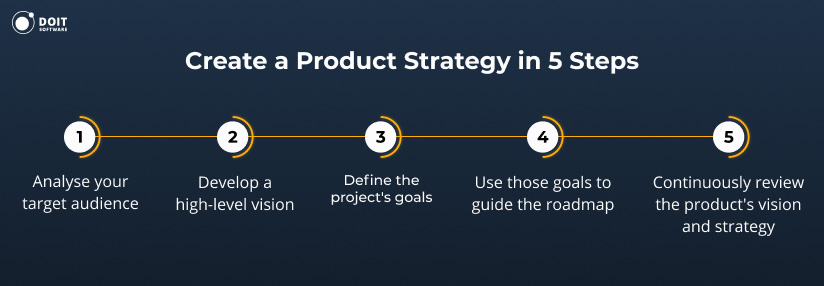
Solution: a well-developed product strategy will help you identify the framework for the development process, deployment as well as post-release follow-up. As a part of the product strategy, you need to define your target market, long-term goals, features prioritization, research on your competition, current market conditions, marketing plan, as well as software maintenance.
Failing to solve a particular problem
In the current abundance of applications, your solution needs to solve a concrete problem that your potential users have. In the beginning, it would suffice if your application solves one particular issue, however, you can expand the functionalities later.
Solution: try to pinpoint what exactly your software will focus on solving. Later, when the issue has been established, identify at which point the problem is considered to be solved. You may include additional features later on, but in the beginning, try to concentrate on the most urgent problem, such as getting a ride using Uber, or making online payments using PayPal.
Miscommunication in the development team
Communication is of course important for any company and any business, but it becomes vital for custom software development companies. The lack of clear communication inevitably leads to building unnecessary features that will drain the budget.
Solution: adopt the agile methodology and have regular meet-ups or calls. Make sure everyone who is involved in the development process takes part in the meetings: developers, operations specialists, QA workers, UX designers, and other stakeholders.
Lack of post-launch plan
Custom software development is not only about writing the app, testing, and launching it. You need a post-launch plan to make sure it generates income. Without an explicit plan for the post-release, your application will get lost in the plethora of tools that are currently on the market.
Solution: post-launch plan entails supporting workflows for sales, marketing, customer service, etc. It should include ongoing app performance monitoring, sales and marketing plan, collecting and utilizing feedback, adding new features to the application, and so on.
Choosing the wrong IT development company
There are a myriad of custom software development companies on the market which makes it difficult to make the right choice. Choosing a custom software development services company that is too small for you will hinder you from expanding and meeting new goals. On the other hand, going for a large provider might feel too impersonal. Moreover, big companies tend to forget how it is for small businesses and overlook some of their needs.
Solution: do thorough research before signing anything with a company. Go through the company’s portfolio, ask them questions about previous projects related to your development, inquire about security issues. The best software companies to work with are always ready to answer your questions, tell you about their cases, and share their expertise on technologies. Additional options to consider are services like staff augmentation or dedicated development team service that extend your in-house personnel with one or several tech specialists to fill in the knowledge gap on your team.

How to make custom app development effective?
How can you make the custom software development process more efficient and avoid beginner mistakes? Luckily, many people and many companies have gone through the mobile and web application development steps, and know first hand how to optimize the process and make it smoother. Let’s look at seven basic steps that will accelerate and simplify your custom development.
Define your current process and future needs
Before hiring the best software development company to build your solution, define the current process and what you need in the future. Without concrete goals and success measurements, the end result will not be easy to assess. You may want to discuss it with the stakeholders and managers at the company to put together a list of the particular processes that the future solution will execute and support.
Choose the right people/partner to work with
What is custom application development without a team? Firstly, evaluate your budget, goals, and preferences when it comes to the software development model. You can build an in-house team at your company or outsource the entire project or its parts to a third-party IT firm.
Hiring in-house workers is a great decision, however, it comes with a high upfront cost as well as ongoing extra costs like office space and supplies, taxes, etc. Outsourcing is a more affordable option, however, you will have less control over the development process. There is also a compromise between the two called staff augmentation. It encompasses the best advantages of both outsourcing and in-house hiring as it provides you with a qualified worker for the duration of the project, and at the same time does not cost as much as actual in-house hiring.
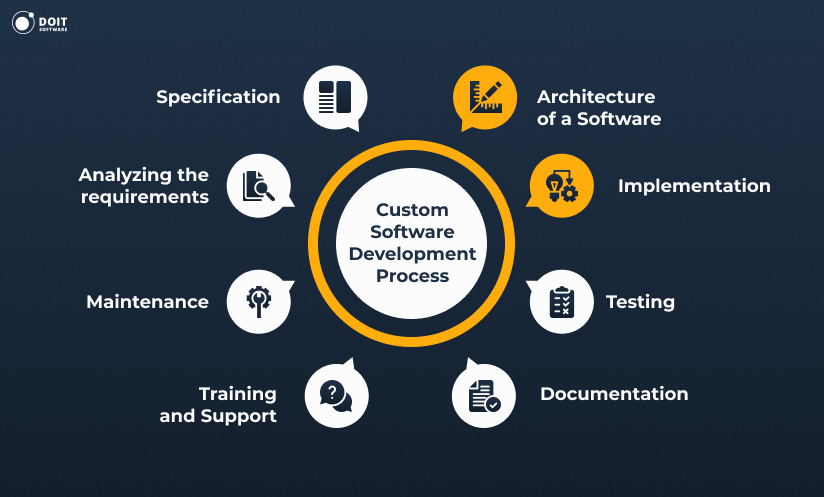
Make a realistic plan with milestones
After setting up your team, together you can create a comprehensive, detailed plan with clear milestones to keep track of your progress. Make sure that everyone involved in the new software development process can contribute to the plan: developers, designers, testers, project managers, and others.
Conduct the appropriate testing
Testing is one of the most important parts of the bespoke software development process. It is so vital that more and more companies include it into their regular workflow instead of leaving it till the end of the development cycle. Testing usually consists of two parts:
-
Firstly, testers and IT professionals continuously play out test scenarios to evaluate how well the application will do in certain situations, such as high traffic spikes.
-
Secondly, the app is deployed to beta-users who assess the performance and the feel of the software in real life.
Time and Budget Estimation
As mentioned before, custom software application development requires a higher investment that needs to be thoroughly measured and planned out. A detailed time and budget estimate covers the scope and features of the software, IU/UX design, infrastructure costs, licenses and cloud fees, and developers’ compensation. These are just a few things that need to be considered when making an estimate. Additional costs may occur, depending on the size and complexity of the application.
Code Reviews and refactoring
It is recommended to conduct code reviews and refactoring every third or forth sprint to make sure the code is clear and correct. An abundance of unnecessary code lines makes the code harder to read and understand, as well as slowing down the performance.
Document the entire process
Documentation applies to both development and implementation stages:
-
The Project plan states the list of requirements, which features will be implemented, and who is responsible for which task.
-
The Test plan covers all testing-related activities;
-
The Scope plan is about staying within the scope of the project, and not pursuing too many goals at once;
-
The Implementation plan addresses the post-launch phase and defines who uses the software;
-
The Training plan teaches users how to use the application.
Summing up
Custom software development presents a variety of benefits for enterprises, SMEs, and startups. Regardless of the industry, building an app that perfectly fits the business goals and processes, target users, and the existing infrastructure, is a huge win for any company. Custom built software will streamline your processes, optimize the workflow, and automate daily tasks. With custom developed software, your company will achieve new goals and attract new users. As stated before, custom software development is not necessarily expensive, as you can add only the features that you need and seamlessly integrate the app into your current environment.
If you have decided that custom software development is something that could benefit your business, contact DOIT Software. DOIT Software offers software application development services, as well as a staff augmentation model that lends you one or several workers to fill in the skill gap for a certain project. We have years of expertise in business software development and are ready to share it with you. We know first hand how to develop software that meets the specific needs of your company and industry.
Home › DOIT Software Services › Custom software development
